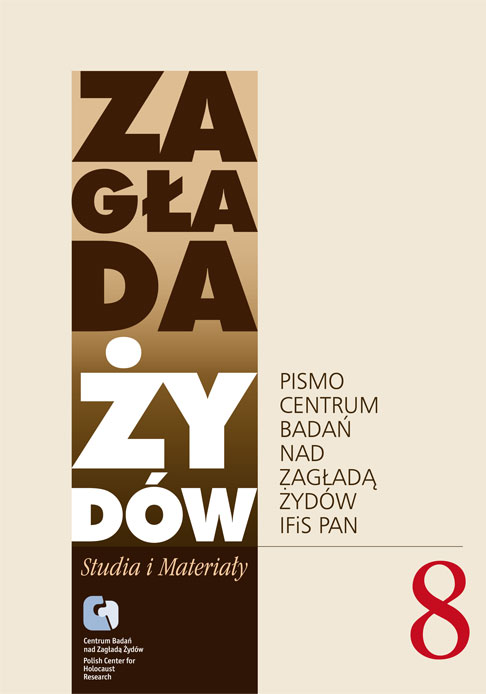Pogłoski w białostockim getcie. Przyczynek do historiografii Zagłady z perspektywy żydowskiej
Zagłada Żydów. Studia i Materiały, Nr 8 (2012), Strony: 214-236
Data zgłoszenia: 2020-10-28Data publikacji: 2012-12-02
 https://doi.org/10.32927/ZZSiM.633
https://doi.org/10.32927/ZZSiM.633
Abstrakt
The article deals with rumors, which were circulated in the Białystok ghetto. It seems that a rumor is a form of collective interpretation of reality whose function is to structure equivocal situations by explaining events or predicting them. The mood and behavior of individuals and groups may be influenced by rumors, in particular if they find themselves – as the Jews in the ghettos – in an exceptional and lifethreatening situation characterized by insecurity, isolation and uncertainty. The article analyzes rumors relating to the deportations of Jews from the ghetto and German mass murder actions. It addresses the following questions: Which impact did the different rumors have? How did the Judenrat and the ghetto population react to them? The article demonstrates that Jews acted upon their apprehension or misapprehension of events and that their subjective evaluation of the German extermination policy influenced their behavior and decisions
Słowa kluczowe
pogłoski , deportacje , niemiecka polityka eksterminacyjna , Judenrat , żydowska perspektywa i zachowania
Licencja
Prawa autorskie (c) 2012 Autor & "Zagłada Żydów. Studia i Materiały"

Utwór dostępny jest na licencji Creative Commons Uznanie autorstwa 4.0 Międzynarodowe.
https://creativecommons.org/licenses/by/4.0
Podobne artykuły
- Marcin Przegiętka, Co o Zagładzie wiedział Adolf Gerteis, prezes Kolei Wschodniej? , Zagłada Żydów. Studia i Materiały: Nr 20 (2024)
- Marek Bem, Tomasz Blatt. Pamięć nie zna przedawnienia , Zagłada Żydów. Studia i Materiały: Nr 12 (2016)
- Martyna Grądzka-Rejak, „Od dłuższego czasu straciłem wszelki kontakt z żydami i żydostwem”. Neofici w okupowanym Krakowie w świetle materiałów Archiwum Kurii Metropolitalnej w Krakowie , Zagłada Żydów. Studia i Materiały: Nr 13 (2017)
- Katarzyna Kuczyńska-Koschany, Erntefest – od etymologii do zastosowania , Zagłada Żydów. Studia i Materiały: Nr 15 (2019)
- Marcin Zaremba, „Ta cała banda żydowska zdechła nareszcie”. Eksterminacja Żydów w listach żołnierzy niemieckich z 1942 r. , Zagłada Żydów. Studia i Materiały: Nr 10 (2014)
- Justyna Koszarska-Szulc, Sandauer w getcie. Rozliczenia literackie i nieliterackie , Zagłada Żydów. Studia i Materiały: Nr 19 (2023)
- Piotr Rypson, Album rysunków Teofili Langnas-Reich w Archiwum Ringelbluma , Zagłada Żydów. Studia i Materiały: Nr 18 (2022)
- Aleksandra Bańkowska, Partyzantka polska lat 1942–1944 w relacjach żydowskich , Zagłada Żydów. Studia i Materiały: Nr 1 (2005)
- Aleksandra Bańkowska, Polish Partisan Formations during 1942–1944 in Jewish Testimonies , Zagłada Żydów. Studia i Materiały: 2008: Holocaust Studies and Materials
- Christoph Dieckmann, Niemiecka polityka okupacyjna na Litwie w latach 1941–1944. Podsumowanie , Zagłada Żydów. Studia i Materiały: Nr 13 (2017)
<< < 1 2 3 4 5 6 7 8 9 10 11 12 13 14 15 16 17 18 19 20 21 > >>
Możesz również Rozpocznij zaawansowane wyszukiwanie podobieństw dla tego artykułu.
 English
English
 Język Polski
Język Polski








